|
|
|
|
|
ABIT NF7 meets Granite Bay |
|
Join the community - in the OCAU Forums!
|
How We Tested, Performance
HOW WE TESTED
For a meaningful comparison between chipsets the influence of the CPU has to be eliminated as much as possible. Of course. we used for the 2 NF7 boards in our tests the same XP 2400+ (AUIHB stepping) CPU. The E7205 board was powered by a Pentium 4 2400 (C1 stepping). Assuming that the AMD PR rating is correct using processors rated at the 2400 MHz performance level should largely eliminate their influence on performance differences. All other peripherals, such as the memory, the video card, the OS, and the benchmarking software were of course identical through all tests and for all boards. An important ingredient when running and overclocking dual DDR boards is naturally the memory. We used our recently tested 2 x 512 MB Winbond DDR 400 chips based Twinmos PC3200 modules.
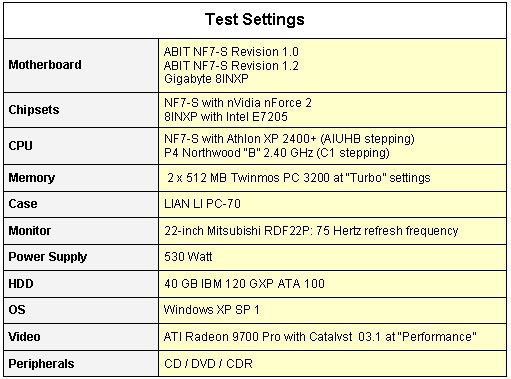

PERFORMANCE
The CPU performance as shown by PC Mark 2002 seems to be identical on both revisions. The Pentium 4 2400 running on our E7205 test board is shown at exactly the same performance level as the XP2400+ running on the 2 nForce 2 boards. That confirms AMD’s PR rating as far as the 2400+ is concerned. It seems that the bandwidth output has slightly improved between revision 1.0 and revision 1.2. More interesting however is to see that PC Mark 2002 as well as Sandra 2003 clearly shows that the E7205 based system is providing better bandwidth than the nForce 2 based systems. The reason here is not the chipset but the Thoroughbred’s bandwidth limitation. Later we will see whether the E7205 bandwidth advantage is relevant for performance. Bandwidth as such has no value, what counts for a PC user is the performance he gets when he is using his PC.
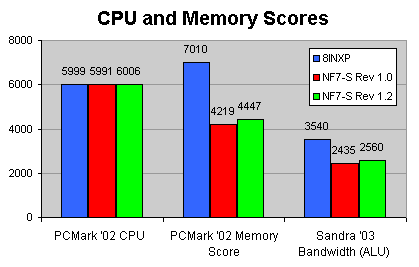
It seems that the new (A3) Northbridge stepping is not providing better gaming performance. Both tested NF7-S revisions are basically performing identical, with revision 1.2 a few points behind. We also see that the E7205 reference board is ahead of both NF7 revisions. These differences are too small however to have any real-world impact. One possible explanation is the “better” bandwidth the E7205 system is enjoying. If this is the case, the impact of the huge bandwidth lead looks rather small though.
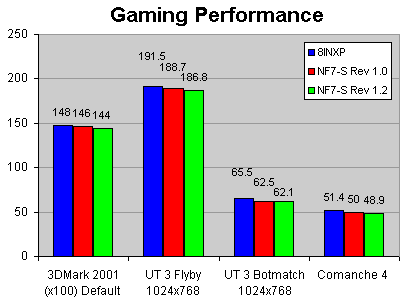
More important are the differences in our 2 Winstone productivity tests. In both tests, Content Creation 2001 and Business Winstone 2002, we see revision 1.2 clearly pulling ahead of revision 1.0. This is probably thanks to the new (A3) Northbridge stepping. NF7 revision 1.0 could not beat the dual channel DDR Pentium 4 system. Revision 1.2 however is outrunning the E7205 board. The huge bandwidth advantage the E7205 chipset is providing did not pay off in our tests. It seems that bandwidth is not the bottleneck anymore. The bandwidth requirements of contemporary applications are obviously already more than satisfied with the level you get with an nForce 2 based system. The additional bandwidth the E7205 it seems is not required anymore and does therefore not translate into performance gains.
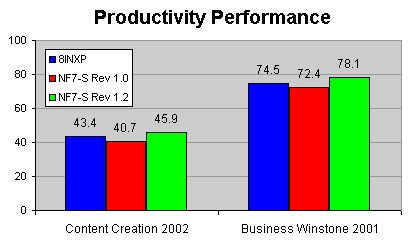
The Winbench 99 Disk Marks show that HDD performance has not changed between revision 1.0 and 1.2. That does not come as a surprise: the data communication with the HDD is managed by the Southbridge, and this part of the system seems to be identical in both NF7 revisions as shown in our pictures. We were surprised however by the huge lead the E7205 board has above the two nForce 2 boards in our HDD test. Disabling the Intel Application Accelerator when running the Winbench 99 test suit did slightly reduce the gap, but not very much. We repeated the Winbench 99 Disk Mark tests several times with similar results. We don’t have an explanation for the huge 8INXP lead. It’s difficult to believe that Intel’s ICH4 is so much better handling the HDD than nVidia’s MCP-T Southbridge.
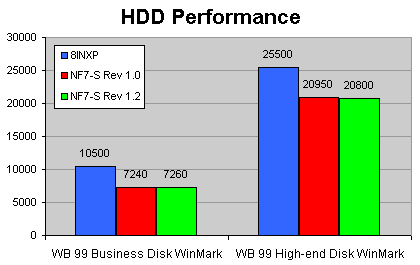
|
|
Advertisement:
All original content copyright James Rolfe.
All rights reserved. No reproduction allowed without written permission.
Interested in advertising on OCAU? Contact us for info.
|

|


